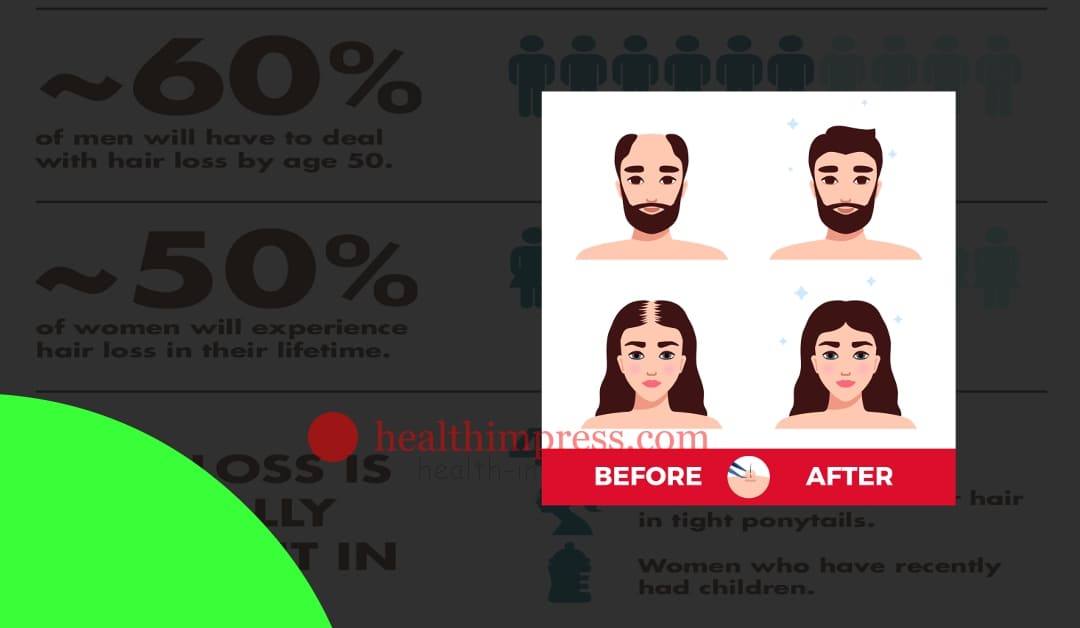Dietary & Supplements, Men's Health, Women's Health
Hair Loss Statistics and Categories
Alopecia, commonly known as Hair Loss or Hairlessness has many causes. Its incidence could be mild hair thinning to complete baldness. In this article on hair loss statistics and categories, we will have a look at what hair loss is, types or categories of hair loss, and some hair loss statistics.
What is hair loss?
Every hair you have has a limited lifespan. It can stop growing, it can fall out, and a new one can grow back. Another fact is, as we age, our hair becomes a little thinner. At times we see some hairs on the pillow and bed, some stuck in the hairbrush, and some in the sink. That is completely normal and cannot be classified as hair loss.
The incidence of hair loss is said to be occurring if more than 100 hairs, in adults are lost every day, and in children, if more than 50 to 80 hair loss occurs.
Note though, that this should be over a period of several weeks, or if individual hairless areas develop, then one can speak of hair loss.
It is all too understandable that hair loss burdens those affected, especially at a young age. In whatever age range you find yourself, it is something that need to be taken care of.
As you may already be aware of, hair loss can lead to hairlessness. The technical term for this is alopecia. On the other hand, effluvium hair loss can be temporary because the hair grows back on its own.
However, if the hair roots have been irreversibly damaged, for example by burns or diseases with scarring hair loss, then no more hair will form on the affected area.
Hair Loss Statistics and Categories
Hair Loss Statistics
In a 2014 survey by the International Society of Hair Restoration Surgery, it was made clear that approximately 35 million men in the United States alone suffer some type of hair loss. In the same vein, there are approximately 21 million women also affected by hair loss.
Hair loss in men is known to increase significantly with age. By age 35, about 40 percent of men suffer from visible hair loss. By age 60, the percentage is a whooping to 65 percent.
The inference here is that by late-forties to early-fifties, almost half of the men suffer from noticeable hair loss.
Surprising though is the statistics for women. It is even higher. In another survey by age 40, about 40 percent of women suffer from a type of hair loss. By the time they turn age 60, over 80 percent of women suffer some level or degree of noticeable hair loss.
Hair loss categories
The Harvard Health Publishing has stated that medically, there are several categories hair loss falls into. This includes:
Telogen effluvium — This is a common form of hair loss that happens approximately two to three months after a major body stress. Such could be a major surgery, a serious infection, or a prolonged illness.
When there is a sudden change in hormone levels, especially in women, and after childbirth, it can also occur.
Its genesis is a moderate amount of hair fall out from all parts of the scalp. This may be noticed on a pillow, on a hairbrush or in the tub. In this type of hair loss, although it is rare to see large bald spots, hair on some parts of the scalp may appear thinner.
Drug side effects — Hair loss can also be triggered as a side effect of certain medications. This may include amphetamines and levodopa, warfarin and heparin, lithium, beta-blockers, etc.
Also, certain medications used in cancer chemotherapy can commonly cause hair loss that affect the entire head. Doxorubicin (Adriamycin) is one of such medications.
Symptom of a medical illness — well, with this type of hair loss, it is a symptom of certain medical illnesses. Examples are systemic lupus erythematosus (lupus), syphilis, a sex-hormone imbalance, or a serious nutritional problem, especially a deficiency of protein, iron, zinc, or biotin.
These deficiencies are noted to be most common in people on restrictive diets and women who have very heavy menstrual flow.
Tinea capitis (fungal infection of the scalp) — This occurs when there is a certain type of fungi infection on the scalp, leading to breaking off of the hair at the scalp surface, which in turn makes the scalp to become scaly or flaky.
It is noted to be the most common form of patchy hair loss in children.
Alopecia areata — The cause of this type of hair loss is unknown. However, it is known to be an auto-immune disease that causes the hair of its sufferers to fall out in one or more small patches.
Notable though is that it is a more common disease in people who have other auto-immune diseases.
This type can cause total loss of hair to its sufferers from the scalp. When this happens, it is known as alopecia totalis.
Traumatic alopecia — This is a hair loss type caused by hairdressing techniques that pull the hair from the scalp. Styles such as tight braiding or cornrowing, exposure of hair to extreme heat and twisting such as with curling iron or hot rollers, or the damage the hair suffers from strong chemicals such as in bleaching, hair coloring, and permanent waves.
Additionally, some people have trichotillomania which is an uncommon psychiatric disorder, in which hair twisting and compulsive hair pulling can cause bald spots.
Constant pressure or tension to the hair – this is a result of the hairstyle one carries, which in trying to style the hair, puts a lot of strain on the hair. This leads to the pathological tearing out (called trichotillomania).
Hereditary pattern baldness, or androgenetic alopecia — This is basically a male’s phenomenon where hair loss follows the typical male pattern, where there is receding front hairline and/or thinning hair at the top of the head.
Notably, it can begin at any age and time in a man’s life or in teen years and is the most common type of hair loss.
Research has noted that it usually is caused by the interaction of three factors:
- male hormones,
- an inherited tendency toward baldness, and
- increasing age.
Many women will develop some degree of female-pattern baldness. In women, thinning occurs over the entire top or crown of the scalp, sparing the front of the scalp.
Take note!
- Women of all ages are more likely to experience circular hair loss than men.
- If a child suddenly experiences hair loss, which is by no means “normal”, it must be thoroughly investigated to determine the underlying cause.
- The development of symptoms can be weeks between the triggering event and hair loss.
- Hair is not always lost immediately. Often, they stop their growth first and switch to recede prematurely.
Conclusion
In this article, I have touched on what hair loss is and given a brief introduction to what hair loss is. I have also given you some tips on caring for your hair as well as the various categories in which hair loss falls. Now the onus rests on you to take care of your hair.
FURTHER READING. Hair Loss Diagnosis and Care
Check our products page HERE
Important NOTE:
This article is for general guidance only and is not intended to be used for self-diagnosis or self-treatment. You should not substitute a visit to the doctor.








just put the link to your blog on my Facebook Wall. very nice blog indeed.